

Is an Asian Union Possible? 10 July 2012.
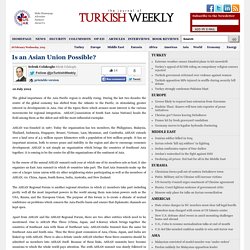
China Proposes New Security Concept for Asia at CICA. Xi Jinping seeks to establish an Asia security framework. China proposes new security concept for Asia. Full coverage: China’s Leaders Full coverage: 4th CICA Summit in Shanghai The theme of the 4th CICA summit is increasing dialogue, mutual trust and collaboration to build a new Asia, that’s peaceful, stable and cooperative.

Chinese president Xi Jinping gave a keynote speech at the opening ceremony this morning. Can China be a normative power? Until now, the west has been attempting to tell China how to behave when it comes to human rights.
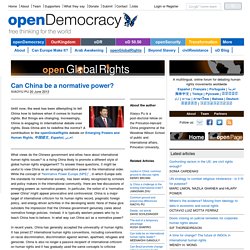
But things are changing. Increasingly, China is engaging in international debate over rights. Does China aim to redefine the norms? A contribution to the openGlobalRights debate on Emerging Powers and Human Rights. 中国语文, Español, العربي. Who will make the rules in tomorrow’s world? Who will make the rules in tomorrow’s world?
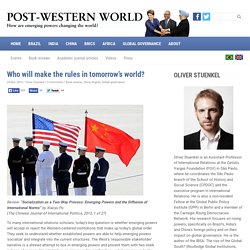
Review: “Socialization as a Two-Way Process: Emerging Powers and the Diffusion of International Norms” by Xiaoyu Pu (The Chinese Journal of International Politics, 2012, 1 of 27) To many international relations scholars, today's key question is whether emerging powers will accept or reject the Western-centered institutions that make up today’s global order. They seek to understand whether established powers are able to help emerging powers ‘socialize’ and integrate into the current structures. The West's ‘responsible stakeholder’ narrative is a shrewd attempt to box in emerging powers and present them with two stark options of responsible integration or irresponsible confrontion - yet it remains up to the system’s creators and norm setters to define what ‘responsible’ and ‘irresponsible’ means. Yet what if emerging powers seek to become not merely well-behaved norm takers, but norm makers? 4. The Relationship between Public International Law and National Law - Dr. Walid Abdulrahim Professor of Law.
The Relationship between Public International Law and National Law Public International Law and national law (municipal law as known in the Common Law Countries) are two legal systems.
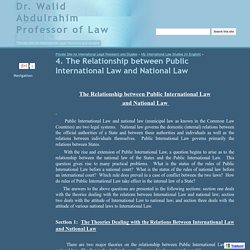
Global-norm-diffusion-in-east-asia-nakano.pdf. Who will make the rules in tomorrow’s world? Twq10octoberchinthakur.pdf. Can China be a normative power? Can China be a normative power? Twq10octoberchinthakur.pdf. China's Asian Infrastructure Investment Bank's First Loan. China's Asian Infrastructure Investment Bank's First Loan Stewart Taggart January 19, 2015 | 0 Comments Print China’s Asian Infrastructure Investment Bank will make its first loan this year.
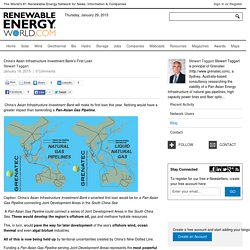
Nothing would have a greater impact than bankrolling a Pan-Asian Gas Pipeline. China, Russia Plan $242 Billion Beijing-Moscow Rail Link. China will build a 7,000-kilometer (4,350-mile) high-speed rail link from Beijing to Moscow, at a cost of 1.5 trillion yuan ($242 billion), Beijing’s city government said on the social networking site Weibo.
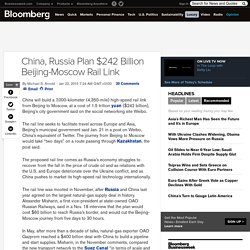
The rail line seeks to facilitate travel across Europe and Asia, Beijing’s municipal government said Jan. 21 in a post on Weibo, China’s equivalent of Twitter. The journey from Beijing to Moscow would take “two days” on a route passing through Kazakhstan, the post said. The Challenge to International Human Rights. This is a chapter in Constructing Human Rights in the Age of Globalization, published by M.E.

Sharpe (April 2003). A commonly held notion among Western liberals is that Asian, African, and Arab perspectives on human rights are the greatest challenge to universality—the implication being that once the international human rights community reckons with the countries of these outlier regions, it will have eliminated the obstacle to universal human rights. This idea is mistaken.
It ignores both the fact that even within the West, particularly in the United States, there are significant numbers of people who hold ideas of human rights that are in tension with the dominant liberal interpretation of international human rights, and the fact that within Asia, Africa, and the Arab world there are strong traditions that are consistent with it.
Who Is Challenging “International Human Rights”? Howard’s fourth category, “left collectivism,” is a reaction against the West. ASEANHR2014.pdf. Effects of Collectivist vs. Individualist Approaches to Ethics on Sino-US Relations - Global Ethics Network. One of the greatest sources of tension between United States and China relations is fundamentally different societal views on ethics.
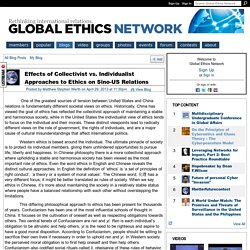
Historically, China has viewed the goal of ethics has reflected the collectivist approach of maintaining a stable and harmonious society, while in the United States the individualist view of ethics tends to focus on the individual and their morals. These distinct viewpoints lead to radically different views on the role of government, the rights of individuals, and are a major cause of cultural misunderstandings that affect international politics. The Asia Cooperation Dialogue (ACD): Progress and Potential. The Asia Cooperation Dialogue (ACD) is an Asia-wide cooperation framework founded in 2002.
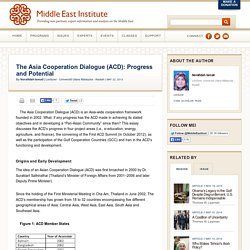
What, if any progress has the ACD made in achieving its stated objectives and in developing a “Pan-Asian Community” since then? This essay discusses the ACD’s progress in four project areas (i.e., e-education, energy, agriculture, and finance), the convening of the First ACD Summit (in October 2012), as well as the participation of the Gulf Cooperation Countries (GCC) and Iran in the ACD’s functioning and development. The idea of an Asian Cooperation Dialogue (ACD) was first broached in 2000 by Dr.
China and the U.S. Alliance System. While the back and forth between the Chinese and U.S. and Japanese speakers at the Shangri-La Dialogue has gained considerable attention, less scrutiny has been paid to the comments by General Wang Guanzhong advocating a “new Asian security concept.” Wang was echoing Chinese President Xi Jinping, who similarly outlined a vision of an Asian security order managed by Asian countries at the fourth Conference on Interaction and Confidence Building Measures (CICA) summit, on May 20-21 in Shanghai, China (Xinhua, May 21, 2014). In many ways, advocacy of a revised security order to better accord with Chinese preferences is not new.
PRC officials first introduced the principles of the new security concept in 1997. Around 2005, Chinese leaders unveiled a series of major concepts, including the Harmonious World, and its derivative, the Harmonious Asia, to provide a clearer vision of how China hoped to shape the global and regional order to accommodate the country’s rise. Security Concerns. China and the U.S. Alliance System. Www.merics.org/fileadmin/templates/download/china-monitor/China_Monitor_No_18_en.pdf.
About cica. Conference on Interaction and Confidence Building Measures in Asia (CICA) is a multi-national forum for enhancing cooperation towards promoting peace, security and stability in Asia. It is a forum based on the recognition that there is close link between peace, security and stability in and in the rest of the world. The Member States, while affirming their commitment to the UN Charter, believe that peace and security in Asia can be achieved through dialogue and cooperation leading to a common indivisible area of security in where all states co-exist peacefully and their peoples live in peace, freedom and prosperity.
The idea of convening the CICA was first proposed by H.E. Mr. Nursultan Nazarbayev, President of the , on 5 October 1992, at the 47th Session of the United Nations General Assembly. What is CICA (and Why Does China Care About It)? What is China’s vision for the Conference on Interaction and Confidence Building Measures in Asia? The Conference on Interaction and Confidence Building in Asia (CICA), to be held in Shanghai next week, is being publicized by the Chinese government as the two most important symbols of China’s “host diplomacy” in 2014, placing CICA on the same level as November’s APEC summit. Given the lack of a security mechanism covering all of Asia, there are hopes CICA can become a template.
Plus, importantly for China, CICA is closely intertwined with the topic of anti-terrorism, from its basic concept to the participating members. CICA was promoted by Nursultan Nazarbayev, the President of Kazakhstan, at the UN General Assembly in 1992. The Northeast Asia Peace and Cooperation Initiative (NAPCI): A Vision toward Sustainable Peace and Cooperation in Northeast Asia. The security environment in the Asia-Pacific is in flux. South Korea is facing the most serious and complex external security environment since the end of the Cold War. Tensions have risen remarkably in Northeast Asia in recent years, sparking growing concern in the international community and among the major players in the region. China’s unilateral declaration of its Air Defense Identification Zone (ADIZ) in late 2013 illustrated the degree of tension in this region.
It posed a very sensitive and complicated problem that involved the strategic interests of China and those of Korea, Japan, and the United States. It has never been easy for Korea to secure its national interests, while not undermining cooperative relations with countries involved in the region; the ADIZ issue symbolizes the challenges it faces as officials and policy experts strive to turn them into opportunities for wise and principled diplomacy. Www.merics.org/fileadmin/templates/download/china-monitor/China_Monitor_No_18_en.pdf. Can China Build a Community of Common Destiny?
Xi Jinping seems determined to build a “community of common destiny” in the Asia-Pacific. So what does that mean? Ever since his refreshing public speech in front of international media in late 2012, Chinese President Xi Jinping has been either creating or stressing quite a number of catchphrases. These phrases help showcase his ideas about how to lead China forward. Xi’s catchphrases or keywords include the China dream, new type of great power relations, and a community of common destiny. In 2007, the phrase “community of common destiny” was officially adopted in Hu Jintao’s 17th National Party Congress report to describe the special cross-strait relationship between mainland China and Taiwan.
China’s Big Diplomacy Shift. China’s decision to elevate in priority its relationship with its neighbors over that with the United States and other great powers, confirmed at the recently concluded Central Work Conference on Foreign Relations, heralds a major shift in its diplomacy. China’s Big Diplomacy Shift. China Is Building a New Silk Road to Europe, And It's Leaving America Behind. China Is Building a New Silk Road to Europe, And It's Leaving America Behind. China’s aspiring global leadership. Author: Thitinan Pongsudhirak, Chulalongkorn University This geopolitical summit season has consolidated ongoing trends in international affairs.
A still-rising China with global leadership aspirations, a resurgent Russia bent on restoring its superpower status, and sclerosis and dysfunction in Western countries is likely to dominate international politics for at least the next 20 years. In fact, we might only be at the beginning in this long time span where seismic global power shifts are taking place. The challenge for countries around the Asia Pacific is what to do and how to respond.
To promote regional peace and stability, China’s global leadership requires measured accommodation, enough to satisfy Beijing’s rightful place in the global order but not so much as to lead the Chinese leadership into an outright expansionist agenda. The maritime beltway across East Asia is also financially backed by Beijing to the tune of US$40 billion. The New Silk Road: China’s Marshall Plan? Will India Join China’s Maritime Silk Road? India is apparently ready to join China’s grand ambition to construct a maritime silk road linking the waters of the Pacific and Indian Oceans according to a Press Trust of India report from Beijing on Friday evening. Seriously! 'New Silk Road' highlights China's two-speed reform. China's dream to revive a 2,000-year old trade route is emblematic of the country's two-speed reform process, according to Barclays.
The legendary Silk Road, named after the lucrative Chinese silk business, spanned three continents until the end of the 14th century. Now, China is spearheading an effort to recreate those trade networks in a project called The New Silk Road. China Is Building a New Silk Road to Europe, And It's Leaving America Behind. China Sees Itself at Center of New Asian Order. Text of Prime Minister’s speech at 2014 SAARC Summit in Nepal. Prime Minister Sushil Koiralaji, my colleagues from South Asia. The Role of Economic Integration in Asia. Aric.adb.org/pdf/Institutions_for_Regionalization_Web.pdf. ASEAN says to further regional economic integration beyond 2015. NAY PYI TAW, Nov. 12 (Xinhua) -- Southeast Asian nations will continue to pursue economic integration "with urgency and resolution" after they achieve the goal of establishing an Association of Southeast Asian Nations (ASEAN) Community by the end of 2015, according to a statement released here after an ASEAN summit on Wednesday.
Why the world must listen more carefully to Asia’s rising powers. Three major nations absent as China launches World Bank rival in Asia - Yahoo Finance Canada. China to establish $40 billion Silk Road infrastructure fund. Central Asia: Can China’s Silk Road Vision Coexist with a Eurasian Union? VIDEO: U.S. Relations with Central Asia after 2014 and the New Silk Road. Xi suggests China, C. Asia build Silk Road economic belt. China's Initiatives of Building Silk Road Economic Belt and 21st-century Maritime Silk Road. Cover Feature - SAARC – A TOOTHLESS TIGER. SAARC AND INDIA:TOOTHLESS OR WITH BONE CUTTER. SAARC: A toothless tiger? China silent on SAARC membership, but ready to elevate ties : World, News. SAARC: A healthy grouping or a dead body? - Cognited. China to establish $40 billion Silk Road infrastructure fund.
ASEAN: The way forward. Www.narendramodi.in/ebooks/KATHMANDU DECLARATION d2014112801.pdf. Www.adbi.org/files/2013.10.25.wp440.asean.economic.community.progress.challenges.pdf. ASEAN says to further regional economic integration beyond 2015. Will Asian trade strategies unite or divide? International Institutions and the Rise of Asia - Drysdale - 2014 - Asia & the Pacific Policy Studies.
Aric.adb.org/pdf/Institutions_for_Regionalization_Web.pdf. Www.asean.org/archive/5187-18.pdf. Www.aienetwork.org/pdfs/Capannelli_and_Tan_Institutions_for_Asian_Integration_Innovatoin_and_Reform_Aug_2012.pdf. ASEAN says to further regional economic integration beyond 2015. Bridging_s3lim.pdf. Why the world must listen more carefully to Asia’s rising powers. New Asian security concept for new progress in security cooperation.
Three major nations absent as China launches World Bank rival in Asia. China Invites U.S., Europe To Join The Asian Infrastructure Investment Bank, Have South Korea And Australia Already Joined? India, 20 others set up Asian Infrastructure Investment Bank. The Truth About China’s ‘Big, Bad’ Infrastructure Bank. China's new world order. Asia Maritime Transparency Initiative. Asia Maritime Transparency Initiative. Regional tensions on display at Fifth Xiangshan Forum. New Asian security concept for new progress in security cooperation. China Creates New ‘Asia for Asians’ Security Forum. Xi Jinping's 'Asia for Asians' mantra evokes imperial Japan.